20 Jul
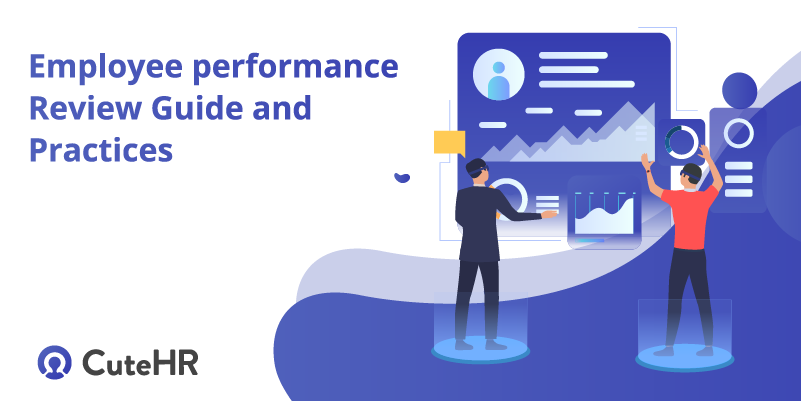
The employee performance review is a key resource of crucial feedback both for the manager and employee. But not knowing what and how to convey such an important message is daunting and risky especially when it is critical to morale-boosting for an employee. So it is of great importance that we get the process right.
Performance Management techniques and strategies are rapidly evolving. Many organizations are inclined towards building a robust performance review process that gives greater objectivity to the system and clarity to the employee. However, many leaders continue to practice old school ideologies that are not that effective in context today.
There is something that is much more scarce, something rarer than ability. It is the ability to recognize ability.”
Robert Half
Also to understand that Performance review conversations between managers and employees cannot be a phenomenon of once or twice a year. While the work equations have become extremely dynamic and the workplaces have become complex to function, the management strategy needs to be strong enough to take care of such scenarios. The important part of the strategy as an organization is to build a competitive review model that validates individual performance against key parameters regularly and provides a scope of learning.
The review process, therefore, needs to be a regular practice for the employee to receive constructive feedback more consistently and the chance to work on the improvement areas before it gets linked with a financial appraisal at the end of the year.
According to some interesting findings around employee performance review, 30% of the employees feel that performance reviews are discouraging and impact productivity at large.
While through a Society for Human Resource Management Survey, it is found that 90% of employee reviews are ineffective and are not rightfully aligned to map the goals and vision of the organization with performance.
With all the ambiguity around the employee performance Review that we discussed above, let us try and focus on the constructive mechanism to describe a comprehensive strategy in conducting a performance review.
Table of Contents
Pointers for a Comprehensive Employee Performance Review
Most companies follow an annual or bi-annual Employee performance review process wherein managers provide performance feedback to their respective team members. While the review might seem objective and effective on paper, these irregular and random reviews at the end of the annual cycle yield only a few tangible or visible results in improving communication and performance at work.
Here is a list of few takeaways to conduct an effective Performace review
Regular One-on-Ones to give informal feedback
Good employee performance can be achieved through empowering people and not controlling them throughout. But As Managers, if you do not know how your team is fairing on regular intervals and the gap areas that might need your immediate attention, how would you design an action plan and take measures accordingly.
Employees require a robust and regular assessment model for their performance to be reviewed and acknowledged. Ask regular feedback questions and share employee performance review messages regularly to stay informed and address any serious concern thereby fostering positive employee performance review, engagement and culture connect.
Also, do not neglect to appraise your high performers. They may not seem to require much guidance or regular feedback but need consistent motivation to drive their passion for work. It is important to acknowledge these top performers to keep them involved and engaged with equal determination. At the end of the day, they are the ones who are shaping a performance culture within the organization.
Stay Honest with the Feedback
As Managers, you should always demonstrate and focus on clear communication within the team. There needs to be clear understanding and transparency on both sides of what expectations the Manager has from the employee as a way forward and what support does the employee needs from the manager.
No employee can be benchmarked as perfect, and there will always be room for improvement. If there is a growing concern that is affecting you and your team, don’t ignore it. Not attending to the issues could lead to some serious implications for the organization and could be detrimental. So never avoid or bypass any situation as Manager and be upfront in raising any alarms if required.
Constructive face to face Discussion
The best way to discuss employee performance review is through one-on-one meetings, with ample time to present and process, listen and then respond to feedback and questions accordingly. This approach provides room for constructive discussion and feedback on both sides and prevents any miscommunications to surface at any level.
Give tangible or concrete examples
As Managers, your feedback is critical for the employee. So the message needs to be clear and factual. If you give vague feedbacks without any factual validations for the same, it will lead to the disgruntled employee with no clarity on expectations. This makes the employee disengaged and negative about the whole process which may prove wrong for your team.
If an employee is falling behind in any certain key performance areas, point it out with some specific examples and address how you as a manager would like those areas to be handled differently.
Identifying and mentioning examples makes employees also careful that their performance is being closely noticed and evaluated. Managers have ‘Responsive’ feedback rather than ‘Reactionary’ with vague statements.
Conclude Discussions on Positive Note
A Constructive employee Performance review is an opportunity to set clear and SMART Goals for the employee.it is a mechanism to highlight what expectations aren’t being met and how an employee can create an actionable plan to achieve the same.
Positive reinforcement of their performance and constructive feedback against the gaps go a long way in giving employees the confidence and the push they need to perform better ahead.
At the same time, the key thing is to identify how well you choose the words to address evaluations. Words like: Achievement, Creativity, Improvement, Ability, etc. foster positive growth and the employee feels valued for what he has done so far and guided positively for the same.
Best Practices to ensure positive feedback includes
- Recognition for positive contributions and guiding for improvement areas.
- Alignment of individual tasks to the team and departmental goals
- Clarification of mutual expectations and resources
- Commitment to pursue continuous improvement plan and conduct follow-ups to review the action plan.
Now let us understand the various steps involved in Conducting Annual employee Performance Review:
Steps of Annual Employee Performance Review
Here are the basic steps to follow for an annual employee performance review activity. You can follow these steps for better outcomes.
Preparing for the Performance Review:
The first step is to check the previous year’s reviews and improvement plans to understand the last conversation and review. Also identify the accomplishments as achieved against the goals, events of exceptional performance, contribution in critical projects, and the challenges encountered in the key areas of improvement.
- Recording the Performance Review:
Write a record of the key discussion points.
- Performance as compared to agreed-upon expectations
- Accomplishments and contributions with examples
- Examples of strengths(SWOT) and roadmap of development opportunities
- Key expectations from the employee for the next year
- Performance Review Conversation:
The most integral aspect of an employee performance review is the review one-on-one conversation. Preparing for the conversation will help you as the Manager to guide a productive conversation with the employee. Evaluate and jot down what to communicate and be prepared to give and receive feedback.
- Focus on observable and measurable performance
- Provide actionable and constructive feedback
- Avoid vague statements or any kind of exaggerations
- Acknowledge the success and position the gaps as an opportunity for learning and re-alignment.
- Post Performance Review:
It is essential to record review meeting discussion points and do a follow up to identify and close any open issues.
Guidelines for Using Employee Performance Review Forms
Employee Performance Review Forms are tools that help to summarize the feedback conversations and record previous year accomplishments objectively along with expectations moving ahead. The selection of a particular type of form and questions will depend upon your objective of review and the information you wish to derive.
Managers may select any employee performance review form that suits the needs of their department and gives them an objective overview of employee performance. However, managers need to use the same form for all employees in a specific job role/ category within a department/area to avoid confusion and discrepancy. Though there could be different forms in the same department as per specific job type.
An employee performance review is valuable for both employees and employers alike from the growth perspective. It highlights what is and isn’t working and how well the individual’s goals within the company are aligned with business goals. It is a channel for identifying areas for growth and create a roadmap for the employee for the future. So choosing a proper approach is a requisite.
Here is a list of key performance review questions that need intelligent review.
List of Key Employee Performance Review Questions
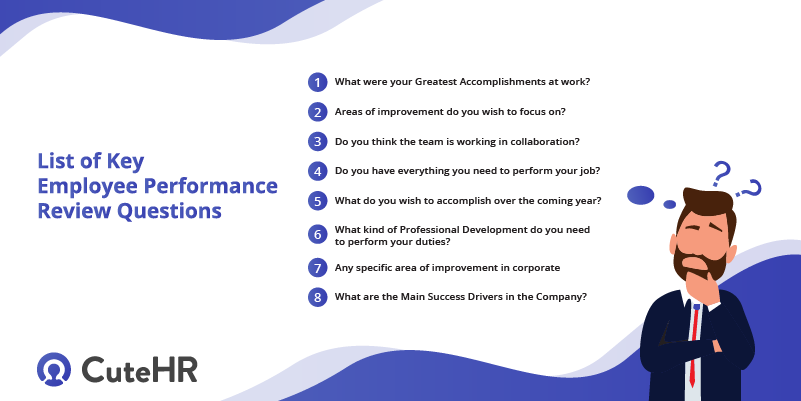
- What were your Greatest Accomplishments at work?
It is an opportunity to showcase the areas they have excelled in. Give weightage to the exemplary display of leadership or teamwork.
- Areas of improvement do you wish to focus on?
Answers to this will reflect if they have a clear understanding of their weaknesses.
- Do you think the team is working in collaboration?
This will help you as Manager to know the Team Dynamics and synergy.
- Do you have everything you need to perform your job?
It is a constructive question as it gives the employee an opportunity to tell you directly their limitations or where they could improve if they are given some additional tool or resource.
- What do you wish to accomplish over the coming year?
This helps to know employee’s goals in clarity within the company and identify how well they are aligned with the company’s vision.
- What kind of Professional Development do you need to perform your duties?
This question will help in training need identification and analysis.
- Any specific area of improvement in corporate culture?
This will reveal if there are any cultural issues within the organization’s environment and the way to deal with them.
- What are the Main Success Drivers in the Company?
This is a good way to learn how well the employee understands the company’s priorities.
Also, there are two ways to drive employee Performance Review
Other Powerful ways to Drive Employee Performance Review
- Subjective Q&A
- KRA Competency Mapping
Subjective Q&A
As stated above, this format exists of specific Q&A around an employee’s job and performance evaluation. This form can be generic to all departments or carry specific questions to highlight areas of a particular department. The employee can fill the form as per his understanding of role and responsibilities which further goes to the Manager for review.
DOWNLOAD THE SELF ASSESSMENT FORMAT
KRA Competency Mapping
This format primarily comprises of Objective KRA and competency against each job role and then grading each employee as per these set KRA’s. This is a more objective way of defining and performance evaluation and focusses on long term employee career aspirations too. It is quite objective and inputs from employees are quantified as per grades.
KRA based Performance Reviews have the following key pointers:
- It is personalized for each employee and connects specific job requirements against key performance indicators.
- Describes objectively how performance will be measured. It gives clear parameter values.
- Weightage is defined as per the criticality of each job responsibility. Each key responsibility is categorized and assigned due weightage as per its specific importance.
Once the appropriate Form has been decided upon and the employee has self appraised his/her performance, it is the Manager’s responsibility to write and document his review and feedback on the same for discussion.
Model to write a comprehensive Employee Performance Review Evaluation
- Always start on a positive note. Highlight and acknowledge the employee’s achievements in the previous year. Her /His continued drive and focus to get things done and make things happen even after different challenges and roadblocks stand as a testimony to his/her performance.
- Identify goals that were achieved. Make sure as Managers you talk about these accomplishments and goals during face to face discussions.
- Identify and note unaccomplished Goals. Apart from appreciating and recognizing excellence, it is important to also review the missed objectives and give fair feedback on the same.
- Outline the Areas of Improvement and support it with constructive measures as a roadmap of identification of training needs and employee development.
- Highlight Clear Expectations for the next year and provide a framework for the employee for the goals to be achieved in the coming year.
Performance Management Software
Organizations today are more aware and serious about measuring and improving their people’s performance and productivity in a structured manner. Performance Management software allows organizations to streamline the process of performance review effectively through online medium and hence provide relevant reports and data for better communications with employees around performance expectations.
Depending on your organization’s size and requirements and end objectives around Performance Review, you can incorporate an open API system or outsource the entire process to a third party. The online system of Employee Performance Review allows managers and HR staff to set and monitor goals more dynamically, and hence also customize reviews. It also automatically solicits responses from managers, employees, and peers through the periodic review cycles.
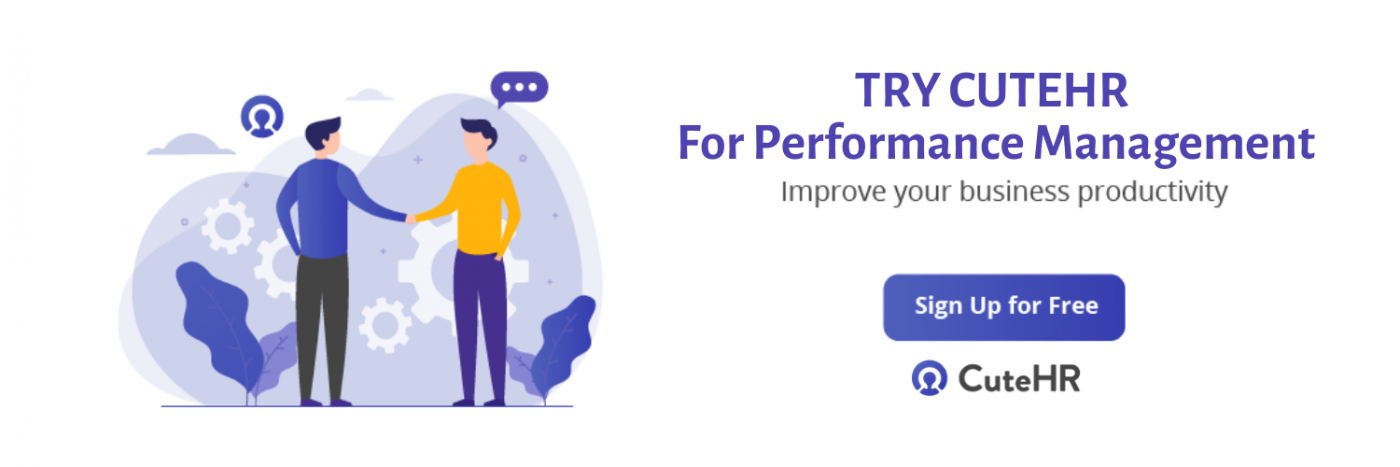
A good quality performance management software system enables and delivers real-time reporting and enhanced communication between employees and management. The platforms easily help you complete the process and store the results for later review thereby reducing any human level glitches. But remember even in such a platform enabled program, you as a Manager still need to be judicious in knowing what to say and how to say it.
The question of whether you need Performance Management Software will depend on your company size and how well salary decisions are linked with performance. Also even after choosing and implementing a particular Performance Management Software, a few pointers needs attention:
- Buy a Software that is simple and easy to use. Choose a Software system that has a user-friendly platform for employees to give their self-assessments easily and for managers to analyze accordingly.
- Don’t be inclined towards measuring everything. The whole idea of Performance Management Software is to get an idea about how things are and not make it so critical and quantifiable.
- Focus on software that captures the scope of conversations with the employees and incorporates certain behavioral parameters rather than just centered on objectivity.
Software is only worthwhile if your company uses it, so consider whether the platform is one that your employees will adopt and whether it is simple and user-friendly. It should have the key features you need and can easily set and track goals that align with a larger vision of the organization.
Lastly, as we know, An Employee Performance review adds value to both the employee and the employer and hence demands detailed attention to conduct the whole process most efficiently.

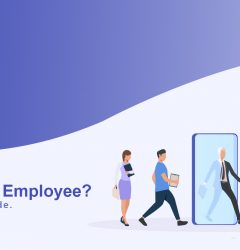
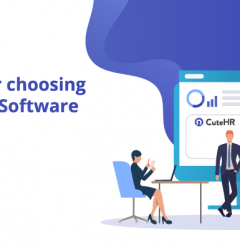







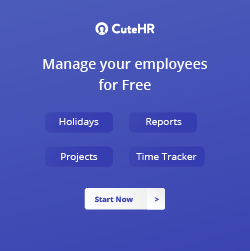

Jyoti Kapoor